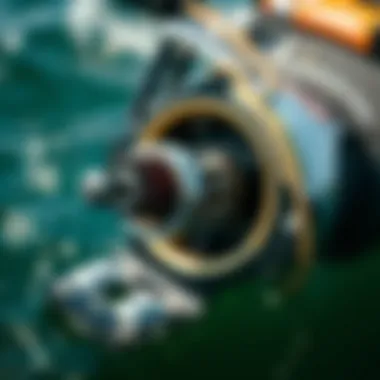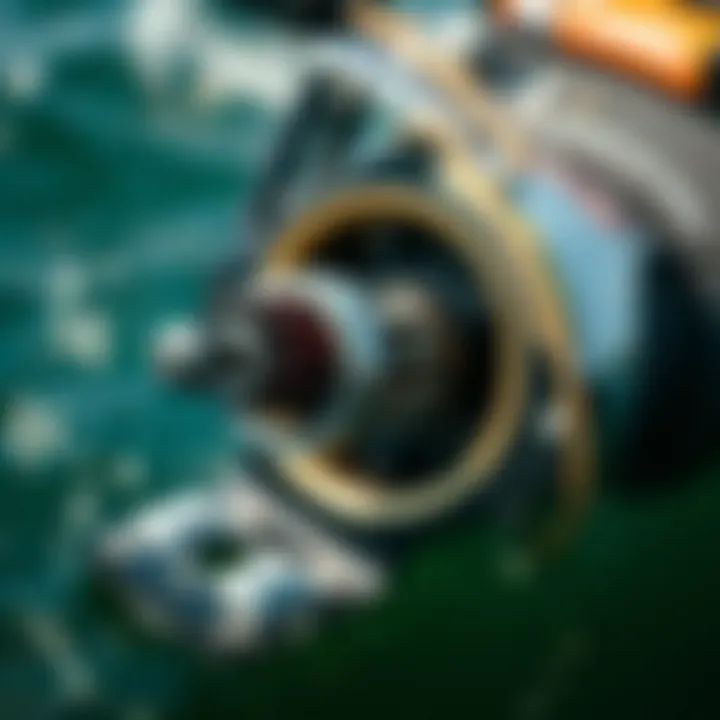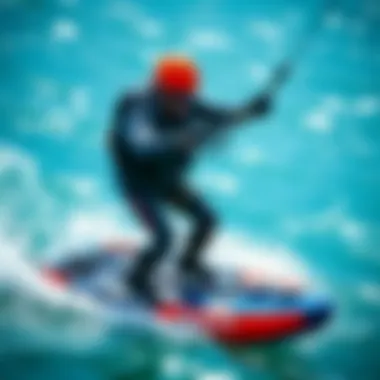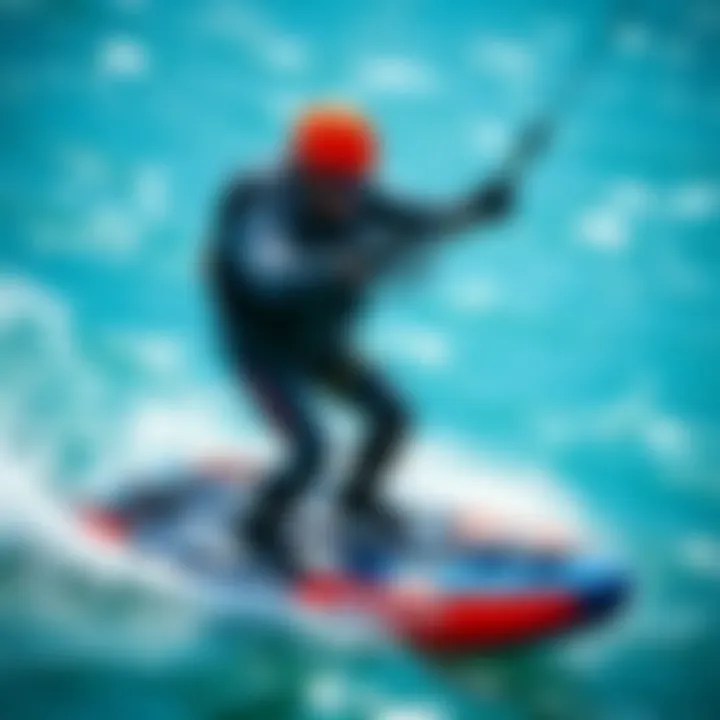Exploring the Mechanics and Future of Efoil Hydrofoiling


Intro
Efoils have emerged as a striking innovation in the domain of water sports. Blending traditional surfing elements with advanced electrical engineering, these devices allow riders to glide above the water with minimal resistance. The consideration of how efoils function, their design intricacies, and performance capabilities portrays a fascinating intersection of sport and technology.
As the popularity of efoiling surges, enthusiasts and professionals alike find themselves intrigued by this unique water activity. It’s not merely about riding a board; it's a playful dance with technology and nature, emphasizing balance and precision. As we delve into this exploration, we will reveal the nuances that make efoiling a captivating and exhilarating experience.
The articles in this series will navigate through various crucial elements - from equipment insights to mastering techniques, aiming to provide comprehensive guidance and valuable tips for both novices keen to get their feet wet and seasoned riders seeking to refine their craft. Let’s gear up and dive into the essential aspects of efoiling.
Equipment Insights
Latest Gear Reviews
In the world of efoils, selecting the right equipment can be daunting. Each efoil brand offers a variety of models, each with its own set of features. For instance, boards like the Lift eFoil and Fliteboard have gained considerable favor amongst riders.
- Lift eFoil: Known for its durability and versatility, this model boasts a speed range of 15 to 25 mph, making it suitable for both beginners and experienced riders. The battery life of approximately 90 minutes offers ample session time to enjoy the thrill on the water.
- Fliteboard: This brand is synonymous with premium quality. Its unique design allows for a highly responsive ride. With a wide range of sizes and wing options, it caters to different weight classes and riding styles, from flat water cruising to catching small waves.
However, it’s not just the boards that matter. Accessories make a substantial impact too - from protective gear such as helmets and impact vests to safety devices like leashes and emergency cut-off switches, each piece plays a pivotal role in ensuring both enjoyment and safety amidst the waves.
Essential Gear Maintenance
Owning an efoil is a commitment that goes beyond the thrill of riding. Proper maintenance extends the lifespan of your equipment and maximizes performance. Here are several essential maintenance tips:
- Battery Care: Always charge the battery following the manufacturer's instructions. Avoid letting it deplete completely before recharge, as this can compromise battery life in the long run.
- Regular Inspections: Check the wings and hydrofoil components for any damage or wear. Even small cracks can lead to greater issues if left unattended.
- Clean and Dry: Rinse your efoil with freshwater after every use, especially when exposed to saltwater. This simple step helps prevent corrosion.
By investing time in maintenance, riders can significantly enhance their overall experience, ensuring safety and longevity.
Technique Exploration
Beginner Techniques
For those just beginning their journey into efoiling, mastering the basics is essential. Starting in calm water conditions will boost confidence. Here are some techniques to ease into efoiling:
- Proper Stance: Position your feet shoulder-width apart, knees slightly bent, and keep your weight centered. This posture aids in balance and stability.
- Throttle Control: Gradually adjust the throttle using the handheld remote. Sudden movements can lead to loss of balance. Start slow, reading the water and your board's response.
Advanced Maneuvers
Once beginners have gotten the hang of it, exploring advanced tricks and techniques becomes the next aim. Riders often gravitate towards aerial maneuvers or making sharp turns. Some advanced maneuvers include:
- Carving Turns: Shift your weight smoothly from one side of the board to the other while initiating turns. Fluid weight transfers improve overall handling.
- Jumping: Learning to time the throttle and weight shifts is crucial for getting airborne. Proper jump technique comes down to precise throttle control and body positioning.
"Mastering efoiling lies in understanding the delicate interplay between equipment, technique, and nature. A successful ride is as much about feeling the water as it is about mastering the mechanics."
As we progress through this exploration, it becomes clear that efoiling is not just another passing trend in water sports.
Prologue to Efoil Hydrofoils
Efoil hydrofoiling is not just redefining the way enthusiasts interact with water; it’s a blend of technology and thrill that captures imagination and challenges conventional water sports. As efoiling grows in popularity, understanding its core elements becomes imperative for participants eager to delve deeper into this exhilarating realm.
First off, efoils represent a fusion of traditional surfing dynamics with modern engineering, offering riders an experience akin to flying just above the surface of the water. This floatation above the ocean creates reduced drag, which translates to a smoother ride and, importantly, has significant implications for energy efficiency—the less drag, the longer one can ride without exhausting the battery.
What is an Efoil?
An efoil, at its simplest, is an electrically powered surfboard equipped with a hydrofoil. This hydrofoil, a wing-like structure beneath the board, lifts it out of the water when the board gains sufficient speed. The propulsion is usually provided by an electric motor, powered by a rechargeable battery. Unlike traditional boards, where water resistance is a limiting factor, efoils glide through the water with nearly no resistance, presenting an almost supernatural riding experience.
Riders control their speed and direction via a handheld remote, making the experience not only thrilling but also accessible for new entrants into the water sports scene. The sensation can range from serene gliding over calm waters to gravity-defying maneuvers on open surf, appealing to a diverse crowd from kiteboarders to casual beachgoers.
History of Hydrofoiling


Hydrofoiling isn't a new concept; its roots trace back to the late 19th century, when it was first developed for boat races. However, it wasn't until the late 20th century that innovations in design and materials began to revolutionize the concept, making it practical and accessible for wider applications, including surfing.
The modern efoil we know today amalgamates insights from windsurfing, kitesurfing, and even those archaic designs, refining them into a more efficient and enjoyable craft. Influence from companies like Lift Foils brought hydrofoiling into the recreational realm, where enthusiasts could experiment and explore this hybrid between surfing and aviation.
Today, the tech has continued to evolve, with startups and seasoned companies alike vying for leadership in the efoil market. The development of lighter materials, efficient motors, and more powerful batteries have significantly enhanced the capabilities and experience, bringing new excitement to riders.
"Hydrofoiling presents a unique intersection of sport and technology, changing the very fabric of water-based recreation."
The Technology Behind Efoils
Understanding the technology behind efoils is crucial for grasping how this innovative water sport has taken off. Efoils combine principles from diverse domains including aerodynamics, hydrodynamics, and electrical engineering to create a unique riding experience. At the heart of efoiling is the ability to rise above the water's surface, offering not just speed but also a sense of freedom that traditional water sports struggle to match. It’s a dance of mechanics and electricity that elevates water sports to a new dimension.
Mechanical Components Overview
Foil Design
Foil design is the cornerstone of an efoil’s efficiency and performance. The foil—a specially shaped structure often resembling an airplane wing—creates lift as the board is propelled forward. In terms of its shape, a longer and narrower foil helps cut through the water more efficiently, reducing drag. This characteristic makes it a popular choice among efoilers.
A unique feature of modern foil designs is their adaptability. Many efoils now offer interchangeable foils that allow riders to tailor their setup based on conditions such as water type, wind speed, and personal skill level. One potential drawback, however, is the learning curve. New riders may find larger or more complex designs harder to manage, hence careful consideration is important when making a selection.
Motor Mechanics
The motor mechanics of efoils are another vital element. An efoil typically houses a brushless electric motor that drives the propeller. This design choice allows for greater energy efficiency and reduced maintenance compared to traditional combustion engines. The integration of motor mechanics into efoils enables a silent and smooth ride—something that especially appeals to nature lovers looking for a less intrusive experience on the water.
One unique aspect is regenerative braking, which allows the motor to act as a generator during descents, enhancing battery life. Yet, some may argue that such technology could complicate repairs or adjustments, depending on the motor configuration.
Battery Specifications
Battery specifications play a pivotal role in an efoil’s overall functionality. Most efoils rely on lithium-ion battery packs, which are lightweight and have a high energy density. This means the battery can power the efoil for longer durations without adding much weight, thus facilitating the lofty experience that riders seek.
A notable feature is the fast-charging technology being integrated into newer models, allowing riders to quickly recharge during breaks. However, the downside to lithium-ion batteries includes their environmental impact and lifespan limitations—a trade-off that enthusiasts must consider.
Electric Propulsion Systems
Electric propulsion systems mark a significant shift in how water sports are approached today. These systems deliver power through sustainable means, which serves not just performance but also advances the sport’s eco-friendliness.
The shift from traditional gas-powered systems represents not just evolution but perhaps a revolution in how enthusiasts experience the water. Riders can glide with little noise, preserving the serenity of nature around them while enjoying the thrill of speed!
The innovation of efoils illustrates a merging of technology with nature, creating a new breed of thrill-seeing included with responsibility.
As efoils continue to advance, both in battery life and propulsion power, a ripple effect is likely to be felt across the broader spectrum of water sports. Riders, instructors, and industry participants stand on the cusp of potentially transformative experiences yet to come.
The technology behind efoils is a compelling synthesis of performance and sustainability, marking a turning point for water sports enthusiasts. As advancements are made, the conversation around efoiling continues to evolve, leaving riders and tech lovers alike eagerly awaiting what innovation will appear next.
Design Considerations
Designing an efoil is not just about slapping a few parts together and hoping for the best. The thought process behind it involves a cocktail of factors that must seamlessly work together to create a reliable and enjoyable experience on the water. Getting the design right significantly influences the performance, safety, and longevity of the efoil, which is paramount for both casual riders and seasoned professionals.
Material Choices
Choosing the right materials is a cornerstone of innovative efoil design. The materials must be both strong and lightweight, as the dynamics of hydrofoiling relies heavily on reducing drag and increasing buoyancy.
- Carbon Fiber: This is the crème de la crème when it comes to efoils. Though it's on the pricier side, its lightweight nature coupled with incredible strength makes it a favorite. Riders experience improved performance, thanks to lesser drag when using carbon fiber.
- Aluminum: A viable alternative often found in budget models, aluminum is sturdy and much cheaper. However, it is heavier, which can negatively impact performance. It’s often used in the structure of the board or mast but may not be the first choice for the foil itself.
- PVC Foam: This is commonly used in the core of boards because its buoyancy aids in rising quickly through the water. Plus, it’s more forgiving when you wipe out.
Each material choice has pros and cons. The key is finding the right balance to meet performance expectations without compromising durability. For instructors or enthusiasts, understanding these materials can help in selecting the right efoil that truly fits their style and needs.
Hydrodynamics and Performance
Hydrodynamics plays a massive role in how an efoil cuts through the water. This aspect is all about how water interacts with the efoil's shape and design. A well-thought-out hydrodynamic profile means that it can slice through the waves instead of fighting against them. A few design elements to keep in mind include:


- Shape of the Foil: A longer, slender foil has the potential for increased lift but requires more speed to perform effectively. Conversely, a shorter and wider foil offers greater stability at lower speeds, appealing to beginners.
- Angle of Attack: Adjusting this correctly can lead to better lift and performance. Riders need to find that sweet spot for optimal hydrofoiling. Too steep, and you’ll get drag; too shallow, and you won’t get the lift you need.
- Surface Area: The surface area of the foils affects lift, drag, and how much effort a rider must exert. Beginners might prefer larger surface areas for easy take-offs, while advanced riders may opt for smaller, more agile strikes for slicing through waves.
These hydrodynamic principles are fundamental in ensuring that efoils perform well under various conditions. As riders evolve in their skills, they may find themselves preferring specific designs tailored for different water conditions or riding styles. Understanding these factors can elevate the riding experience—not just for personal enjoyment, but as instructors guiding newcomers into this exhilarating sport.
"The right design choices can turn a simple ride into a dance with the waves, making every stroke and glide an experience to remember."
In summary, the design considerations of efoil hydrofoiling are crucial for safety, performance, and user experience. Selecting appropriate materials and understanding hydrodynamics can significantly affect both performance on the water and the overall satisfaction of the riders. This careful balance of engineering and creativity ensures that every devil-may-care turn on the water is nothing short of thrilling.
Advantages of Efoiling
Efoiling represents more than just a thrilling water sport; it signifies a remarkable evolution in how we engage with water environments. This section emphasizes why understanding the advantages of efoiling is crucial, particularly for kiteboarders, instructors, and enthusiasts who seek to broaden their experience on water. The seamless blend of innovative technology, performance, and sustainability highlights why efoiling is becoming increasingly popular.
Environmentally Friendly Alternatives
As the world becomes more attuned to environmental concerns, efoiling stands out as a beacon of eco-friendliness. Unlike traditional gas-powered watercraft, efoils operate on electric propulsion, minimizing harmful emissions and noise pollution.
- Reduced Carbon Footprint: Since efoils utilize electric energy, they can reduce the overall carbon footprint associated with water activities. Users can enjoy the thrill of gliding over water without leaving a significant environmental impact.
- Clean Energy Potential: When paired with renewable energy sources, efoils can contribute to sustainability in water sports. Using solar or wind energy to charge efoil batteries amplifies their green credentials.
- Ecosystem Preservation: Traditional powerboats can disrupt marine life due to noise and fuel spills. Efoiling, however, allows riders to float quietly above the water, respecting aquatic ecosystems. This leads to less disturbance for wildlife, from fish to birds, making it a more nature-friendly recreational option.
Accessibility to Wider Audiences
Efoiling serves as a bridge for various audiences, making water sports more inclusive. It has the potential to attract a wide array of users, from thrill-seekers to those who may be physically limited in conventional water sports.
- User-Friendly Experience: The learning curve for efoiling is generally gentler compared to that of traditional hydrofoiling or kiteboarding. The technology is designed to facilitate balance and control, catering to novice riders who may find traditional methods daunting.
- Age and Ability Inclusivity: Efoiling has expanded accessibility for older adults or those with physical disabilities. The buoyancy provided by the foil allows users to experience the thrill of flying above water without unsustainable effort. This opens the door for more people to engage with water sports irrespective of their physical limitations.
- Affordability and Availability: While the initial investment in efoils may seem steep, various manufacturers are developing more affordable options. As production scales up and technology advances, efoils are becoming accessible to a broader audience, making this sport less exclusive and more welcoming.
"The future of water sports lies in inclusivity and sustainability. Efoils are paving the way for a new era."
Safety Protocols and Regulations
When venturing into the captivating world of efoil hydrofoiling, safety cannot be an afterthought. It’s not just about the thrill of gliding above water; it involves responsibility toward oneself and others. Understanding safety protocols and regulations is paramount for both new and seasoned enthusiasts. By adhering to these guidelines, one can enjoy the liberation of efoiling while minimizing risks.
Operational Safety Measures
Operational safety revolves around practical steps that every efoil rider should observe. These measures are not merely suggestions but essential practices aimed at protecting lives and ensuring a positive experience on the water. Here are key considerations:
- Wear a Personal Flotation Device (PFD): It’s important to always wear a quality PFD. This is your first line of defense in case of unexpected mishaps.
- Familiarize Yourself with the Equipment: Knowing your efoil's components—from the battery to the remote control—can avert malfunctions and create a seamless experience.
- Ensure Adequate Space: Efoiling is best enjoyed in locations away from heavy boat traffic, swimmers, and wildlife. Knowing your surroundings can prevent accidents and unwanted encounters.
- Start in Calm Waters: For novices, beginning in calm waters helps to build confidence and control. As skills develop, one can venture into more challenging conditions.
- Be Aware of Weather Conditions: Wind and wave heights can change quickly, so keep an eye on weather forecasts and avoid efoiling in severe conditions.
"Safety first, so we can enjoy efoiling forever"
Each of these measures offers a layer of protection; together, they create an environment conducive to enjoyment without undue risk. Furthermore, understanding these safety protocols before hitting the water can greatly enhance your overall experience.
Legal Considerations in Efoiling
Legal considerations in efoiling mirror the complexities found in other water sports, but due to the unique nature of efoiling, there are specific regulations to keep in mind. Compliance helps to safeguard individuals and the environment alike. Here’s what you need to know:
- Check Local Regulations: Different regions have various laws concerning efoiling, including where it’s permissible to ride. Some areas may have designated zones, while others might ban efoils altogether.
- Registration of Equipment: In certain jurisdictions, registering your efoil, particularly if it has a motor exceeding a specific horsepower, is required. Ignorance of such regulations can lead to fines or confiscation of equipment.
- Insurance Considerations: Just like with any other sport, having liability insurance for efoiling can protect you from potential lawsuits should an incident occur.
- Environmental Regulations: Efoiling should be conducted in a way that doesn’t disturb marine ecosystems. Be mindful of eco-sensitive areas to avoid fines and maintain sustainable practices.
By being informed and compliant, riders can ensure that efoiling remains a cherished sport for years to come. Whether it's by taking steps for personal safety or adhering to local laws, enhancing one's efoiling knowledge creates a safer and more enjoyable experience for everyone involved.
For further information on legal aspects and regional guidelines, you can visit National Association of State Boating Law Administrators or check local regulations at boating regulatory agencies.
The joy of efoiling lies not only in the thrill of the ride but also in the safety protocols we put in place. Recognizing that safety first translates to limitless fun will make sure that efoiling remains a captivating adventure in our lives.
Efoiling vs. Traditional Water Sports
The emergence of efoiling has sparked a dynamic conversation regarding its place in the arena of traditional water sports. With a surge in popularity, efoiling brings new tools, techniques, and even a fresh mindset to the outdoor aquatic experience. This section will explore how efoiling compares to more established water sports, including crucial elements that define their performance, and the unique experiences each offers.
Comparative Performance Analysis
When looking at performance, efoiling stands out in several key ways. The most noticeable difference is speed and agility. Efoils operate using a hydrofoil that lifts above the surface of the water, allowing for impressive speeds, often surpassing traditional surf or paddle sports. The hydrofoil's design minimizes drag, giving riders the ability to glide effortlessly with a smooth ride uninterrupted by surface turbulence.


- Speed: Efoils can reach speeds upwards of 25 mph, significantly more than a typical surfboard or stand-up paddleboard, which generally max out between 10 to 15 mph under ideal conditions.
- Maneuverability: Efoils allow users to perform tight turns and quick maneuvers, taking advantage of the reduced friction caused by the foils. Traditional boards, while possibly more challenging and skill-oriented, require more energy and technique to achieve similar dynamics.
- Flexibility: Efoiling allows access to more varied water conditions. Whether it's choppy waves or calm lakes, efoils perform consistently, while traditional sports may encounter limitations based on weather and water conditions.
In summary, the performance of efoiling provides an adrenaline rush combined with efficiency, posing unique advantages over conventional water sports.
User Experience Differences
User experience in efoiling versus traditional water sports often brings to light distinct perspectives and sensations. While both efoiling and traditional water sports deliver joy, the manner in which they engage participants varies greatly.
- Ease of Learning: Efoiling may be seen as easier for beginners. The propulsion system can help new riders find their footing with less effort. In contrast, traditional sports like surfing often demand significant time to master balancing and paddling techniques initially.
- Sensory Experience: Riding an efoil is akin to flying above the water's surface. Many riders describe it as a floating sensation, giving a sense of freedom and transcendence over the ocean. On the other hand, the tactile engagement with waves in traditional surfing presents its own thrills, with each wave providing a unique ride worth relishing.
- Community and Culture: Traditional water sports have evergreen and rich histories filled with culture and community, often passed down through generations. Efoiling, being a newer sport, is still building its community and culture, which might appeal more to tech enthusiasts or those seeking an innovative experience. However, there’s a growing camaraderie among efoilers, crafting connections that are unique in their own right.
"Efoiling turns the ocean into a playground, redefining how we experience water, but the waves and wind in surfing maintain a timeless essence that resonates through generations."
As both efoiling and traditional water sports tweelve into their unique experiences, aficionados of either can appreciate the nuances while potentially bridging their worlds for an exhilarating day on the water.
Future Trends in Efoiling
The field of efoiling continues to evolve, presenting exciting opportunities and challenges for enthusiasts and professionals alike. Looking ahead, several key trends can be observed that will not only shape the technology but also influence how the water sports community, particularly kiteboarders and instructors, interact with this innovative medium. Understanding these trends is paramount for anyone wishing to stay ahead of the curve in the world of efoiling.
Technological Innovations on the Horizon
Advancements in Battery Technology
As the heart of any efoil, the battery is undoubtedly a focal point of ongoing innovation. Rapid advancements in battery technology are paving the way for more efficient energy storage solutions. For instance, lithium-ion batteries have been the backbone of efoil systems, but the industry is now eyeing solid-state batteries. These newer batteries promise a higher energy density, longer life span, and improved safety compared to their predecessors.
Notably, a key characteristic of solid-state batteries is their ability to operate at broader temperature ranges, which can be especially beneficial for outdoor sports where conditions fluctuate. Moreover, efoiling with enhanced battery technology means longer ride times without worrying about recharging frequently. This is a game changer for those looking to explore wider waterways without stress.
While the benefits are substantial, there’s a flip side as well. Solid-state batteries are still in their infancy, which means they may come at a premium cost. Furthermore, manufacturing challenges can pose scalability issues for widespread adoption. Nevertheless, as production techniques improve, the hope is that these features will become standard in upcoming efoil models, thus revolutionizing the sports landscape.
Integration of AI into Efoils
Artificial Intelligence (AI) is weaving its way into various sectors, and efoiling is no exception. The integration of AI into efoil systems can enhance user experience in ways previously thought to be the stuff of dreams. One of the standout advantages is the development of smart control systems that can adjust motor performance based on real-time data, including rider weight, water conditions, and desired speed. This not only improves efficiency but also ensures a smoother ride.
A unique feature of AI-enabled efoils is their ability to learn from user habits. As riders become accustomed to their equipment, AI can adapt the settings to optimize performance and safety. For instance, new riders may benefit from increased stability, while seasoned veterans can explore advanced settings that push their skills to the limit.
However, the implementation of AI isn’t without drawbacks. The technology may increase the initial cost of efoils, which might deter some potential users. In addition, reliance on AI may lead to a learning curve for those who prefer traditional riding methods. Balancing these high-tech features with user-friendly designs will be key to appealing to the broader audience of kiteboarders and instructors.
Market Growth Predictions
The efoiling market is anticipated to witness significant growth in the coming years. Analysts predict that as awareness spreads and technology continues to improve, the number of enthusiasts engaging in efoiling will swell. Factors driving this increase include:
- Technological Advancements: With better batteries and smarter designs, entering the sport will become more exciting and accessible.
- Wider Audience Appeal: The graceful nature of efoiling, combined with its unique experience, is likely to attract not just seasoned water sports participants but also novices seeking new thrills.
- Economic Viability: As manufacturing processes mature, the costs associated with efoiling gear should decrease, making it easier for more kiteboarders to join the movement without breaking the bank.
In summary, the future of efoiling shines bright with pathways leading to enhanced technology, market growth, and user engagement. Keeping an eye on these trends can help aficionados and professionals navigate their way through the waves of innovation, ensuring they’re well-equipped to embrace this thrilling sport as it evolves.
End
The conclusion of this article encapsulates the vibrant world of efoil hydrofoiling, weaving together the myriad insights uncovered throughout our exploration. It’s crucial to grasp not just the mechanics and technology of efoils, but also the transformative impact they hold over the realm of water sports, particularly for those already familiar with traditional boardsports such as kiteboarding.
Summarizing Efoil Benefits and Considerations
Efoils offer a plethora of advantages that set them apart from conventional watercraft. Here are a few key points to consider:
- Reduced Environmental Impact: Efoils, being electric-powered, contribute less to water pollution compared to gas-powered alternatives. This shift is significant as we look toward sustainable outdoor leisure activities.
- Accessibility: Hydrofoiling has a steeper learning curve than typical surfing or kiteboarding. However, efoils democratize the sport, allowing beginners to experience the thrill of flying over water with less physical exertion.
- Enhanced Performance: The combination of advanced aerodynamics and electric propulsion permits riders to gain speed and efficiency unprecedented in traditional boardsports, opening up new possibilities in terms of tricks and maneuvers.
- Versatility: Efoils can be used in a variety of settings, from lakes to oceans, making them more adaptable compared to traditional boardsports that sometimes rely on specific wind or wave conditions.
"In the ever-changing water sports landscape, efoiling stands as a beacon of innovation, combining the thrill of the ride with an emphasis on safety and sustainability."
Yet, along with the benefits come vital considerations. The learning curve, equipment cost, and even battery sustainability must be factored into an enthusiast’s journey into this exhilarating world. The commitment to learning how to master efoiling can deter some, but the reward is a unique experience on the water.
Final Thoughts on Efoiling's Place in Watersports
As we look ahead, it’s clear that efoiling has carved out a niche in watersports that is rich with potential. The blend of traditional riding elements with cutting-edge technology is not just a passing phase; it represents a shift. For kiteboarders and other water sport enthusiasts, efoiling provides an exciting avenue for exploration and creativity.
In summation, efoiling is more than a trend. It embodies a movement towards inclusivity, innovation, and environmental consciousness within the water sports community. As more people embrace this unique experience, efoiling could redefine leisure on the water, encouraging both seasoned riders and newcomers to engage in a sport that balances adventure and responsibility.
For those on the fence, the call to try efoiling is loud and clear: step onto this electric ride and see where the waves take you!







